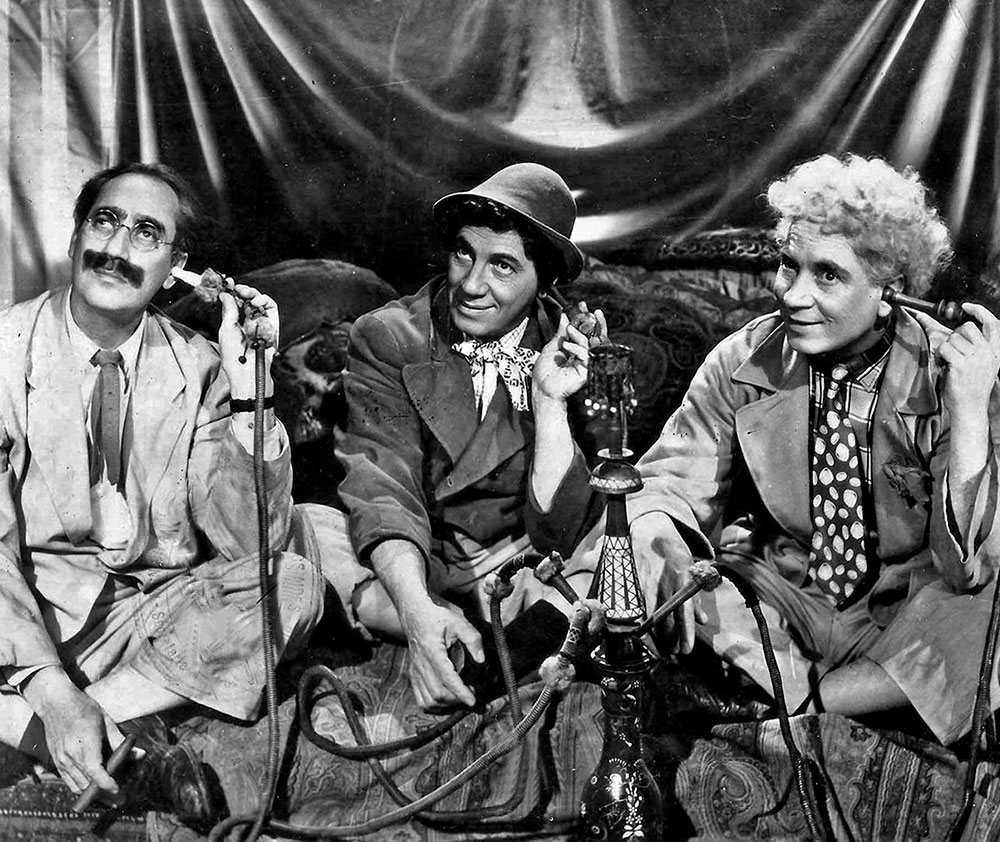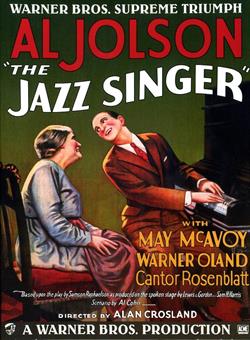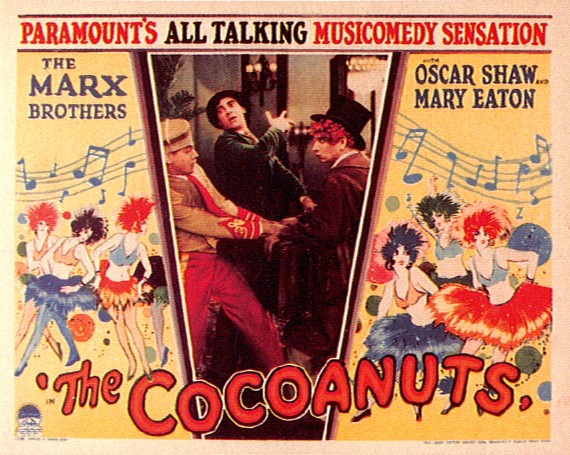Hollywood: The Films that Made the Marx Brothers Legends
Dec 12, 2017

The Depression weighed heavily on Broadway. With shrinking audiences, closing theatres and around 25,000 artists out of work, New York’s Theater District seemed rather bleak. Across the country, however, the motion picture industry was taking off. Hollywood quickly became the new home to actors, writers, directors, composers and everyone in between — including the Marx Brothers.
After opening I’ll Say She Is on Broadway in 1923, the Marx Brothers enjoyed theatrical success with The Cocoanuts and Animal Crackers. The latter would mark their last stage production of the time. New technology in the burgeoning film industry paved the way for the brothers to cement their legacy as bonafide film stars.
In 1927, Warner Brothers — then one of the biggest studios in Hollywood — released the game-changing musical, The Jazz Singer, which was the first feature-length film to incorporate sound. It was a tremendous success, despite the poor quality of the sound itself, as audiences had not been treated to that kind of movie magic just yet.
 Films had already been growing in popularity throughout the 1920s, but the addition of live audio allowed it to skyrocket and become a national pastime. Technology, however, was slow to catch up with demand. Many of the first films revealed clunky operator handling, misplaced microphones, synchronization issues and awkward physical performances. (Look no further than the 1952 classic film Singin’ in the Rain for a humorous take on Hollywood’s transition to sound.)
Films had already been growing in popularity throughout the 1920s, but the addition of live audio allowed it to skyrocket and become a national pastime. Technology, however, was slow to catch up with demand. Many of the first films revealed clunky operator handling, misplaced microphones, synchronization issues and awkward physical performances. (Look no further than the 1952 classic film Singin’ in the Rain for a humorous take on Hollywood’s transition to sound.)
Shaky technology didn’t stop studios from banking off sound’s allure, though. Borrowing slyly from the ailing theatre industry, Hollywood studios began to churn out film versions of theatrical productions in what was known as “canned theatre.” These lower-quality, quickly made films were literal, word-for-word transcriptions of plays that were popular on Broadway, and they relied mostly on the appeal of new technology rather than narrative substance.
In fact, the Marx Brothers’ first film, The Cocoanuts, was an adaptation of their Broadway show. They filmed it in Astoria Studios in New York during the day while performing Animal Crackers live at night. The sound was audibly poor and lacked finessing, but the physical comedy of the film still made it hilarious. By the time the brothers made their second film, an adaptation of Animal Crackers just one year later, many of the sound issues had been resolved.

Dubious as it may have been, canned theatre opened many doors for theatre artists. Silent film stars were replaced with stage actors given their skills in delivering lines. Studios hired playwrights and composers straight from theatre to raise the quality of stories. By the early 1930s, studios shifted away from canned theatre to narratives built for the screen.
Theatre artists also found new residence in the film industry by way of slapstick comedy. In the silent era, filmmakers like Mack Sennett produced short movies that had outlandish comedy as purely visual humor, featuring the likes of Charlie Chaplin and Fatty Arbuckle. But the addition of sound allowed comedy to take on a new form, and the Marx Brothers were among the select few to perfect it. Jokes and bits that had only been seen in live vaudeville could now be captured on celluloid — this included Groucho’s snappy one-liners and Harpo’s musical bits.
With a nod to the slapstick silent films that preceded them, the Marx Brothers’ films were full of madcap mayhem and anarchic hijinks. A Night at the Opera is known for the scene in which 15 people try to cram into a tiny ship’s cabin, and Duck Soup features Groucho and Harpo in a duel of doppelgangers in the famous “mirror scene.” They also used their signature form of insult to poke fun at the elite. Monkey Business found them unwittingly causing a stir between rival gangsters aboard a luxury ship. Horse Feathers showed them hilariously upending the prestige of college football. And A Day at the Races featured one of Groucho’s favorite roles as Hugo Z. Hackenbush, a horse doctor who masquerades as a neurologist.

Their early films found major success upon release, especially since they offered up laughs in a time when they were sorely needed. During the Depression, audiences flocked to the movie theatre as a means of escape. President Franklin Roosevelt even observed, “during the Depression, when the spirit of the people is lower than at any other time, it is a splendid thing that for just 15 cents, an American can go to a movie and look at the smiling face of a baby and forget his troubles.” The Marx Brothers may not have featured smiling babies, but their pitch-perfect comedy was certainly able to let viewers to forget their troubles and just laugh.
The brothers’ bankability baited major players in Hollywood, allowing them to star in 14 films together. After their 1949 film Love Happy was released, they each tread different paths. Gummo and Zeppo flourished on the financial side of show business. Harpo went on comedy tours both nationally and internationally. Chico formed his own band. Groucho headed towards radio and television, heading You Bet Your Life, which played in both media forms.
Groucho enjoyed perhaps the most fame out of the five siblings — his greasepaint makeup and cigar are iconic comedy markers and his one-liners are still quoted today. To learn more about him, the Marx Brothers and their hilarious antics, see Frank Ferrante as the cigar-puffing legend himself in An Evening With Groucho until Sunday Dec. 17. Visit our production detail page for more information.
After opening I’ll Say She Is on Broadway in 1923, the Marx Brothers enjoyed theatrical success with The Cocoanuts and Animal Crackers. The latter would mark their last stage production of the time. New technology in the burgeoning film industry paved the way for the brothers to cement their legacy as bonafide film stars.
In 1927, Warner Brothers — then one of the biggest studios in Hollywood — released the game-changing musical, The Jazz Singer, which was the first feature-length film to incorporate sound. It was a tremendous success, despite the poor quality of the sound itself, as audiences had not been treated to that kind of movie magic just yet.
 Films had already been growing in popularity throughout the 1920s, but the addition of live audio allowed it to skyrocket and become a national pastime. Technology, however, was slow to catch up with demand. Many of the first films revealed clunky operator handling, misplaced microphones, synchronization issues and awkward physical performances. (Look no further than the 1952 classic film Singin’ in the Rain for a humorous take on Hollywood’s transition to sound.)
Films had already been growing in popularity throughout the 1920s, but the addition of live audio allowed it to skyrocket and become a national pastime. Technology, however, was slow to catch up with demand. Many of the first films revealed clunky operator handling, misplaced microphones, synchronization issues and awkward physical performances. (Look no further than the 1952 classic film Singin’ in the Rain for a humorous take on Hollywood’s transition to sound.)
Shaky technology didn’t stop studios from banking off sound’s allure, though. Borrowing slyly from the ailing theatre industry, Hollywood studios began to churn out film versions of theatrical productions in what was known as “canned theatre.” These lower-quality, quickly made films were literal, word-for-word transcriptions of plays that were popular on Broadway, and they relied mostly on the appeal of new technology rather than narrative substance.
In fact, the Marx Brothers’ first film, The Cocoanuts, was an adaptation of their Broadway show. They filmed it in Astoria Studios in New York during the day while performing Animal Crackers live at night. The sound was audibly poor and lacked finessing, but the physical comedy of the film still made it hilarious. By the time the brothers made their second film, an adaptation of Animal Crackers just one year later, many of the sound issues had been resolved.

Movie poster for The Cocoanuts.
Dubious as it may have been, canned theatre opened many doors for theatre artists. Silent film stars were replaced with stage actors given their skills in delivering lines. Studios hired playwrights and composers straight from theatre to raise the quality of stories. By the early 1930s, studios shifted away from canned theatre to narratives built for the screen.
Theatre artists also found new residence in the film industry by way of slapstick comedy. In the silent era, filmmakers like Mack Sennett produced short movies that had outlandish comedy as purely visual humor, featuring the likes of Charlie Chaplin and Fatty Arbuckle. But the addition of sound allowed comedy to take on a new form, and the Marx Brothers were among the select few to perfect it. Jokes and bits that had only been seen in live vaudeville could now be captured on celluloid — this included Groucho’s snappy one-liners and Harpo’s musical bits.
With a nod to the slapstick silent films that preceded them, the Marx Brothers’ films were full of madcap mayhem and anarchic hijinks. A Night at the Opera is known for the scene in which 15 people try to cram into a tiny ship’s cabin, and Duck Soup features Groucho and Harpo in a duel of doppelgangers in the famous “mirror scene.” They also used their signature form of insult to poke fun at the elite. Monkey Business found them unwittingly causing a stir between rival gangsters aboard a luxury ship. Horse Feathers showed them hilariously upending the prestige of college football. And A Day at the Races featured one of Groucho’s favorite roles as Hugo Z. Hackenbush, a horse doctor who masquerades as a neurologist.

Groucho, Chico and Harpo Marx, c. 1946.
Their early films found major success upon release, especially since they offered up laughs in a time when they were sorely needed. During the Depression, audiences flocked to the movie theatre as a means of escape. President Franklin Roosevelt even observed, “during the Depression, when the spirit of the people is lower than at any other time, it is a splendid thing that for just 15 cents, an American can go to a movie and look at the smiling face of a baby and forget his troubles.” The Marx Brothers may not have featured smiling babies, but their pitch-perfect comedy was certainly able to let viewers to forget their troubles and just laugh.
The brothers’ bankability baited major players in Hollywood, allowing them to star in 14 films together. After their 1949 film Love Happy was released, they each tread different paths. Gummo and Zeppo flourished on the financial side of show business. Harpo went on comedy tours both nationally and internationally. Chico formed his own band. Groucho headed towards radio and television, heading You Bet Your Life, which played in both media forms.
Groucho enjoyed perhaps the most fame out of the five siblings — his greasepaint makeup and cigar are iconic comedy markers and his one-liners are still quoted today. To learn more about him, the Marx Brothers and their hilarious antics, see Frank Ferrante as the cigar-puffing legend himself in An Evening With Groucho until Sunday Dec. 17. Visit our production detail page for more information.